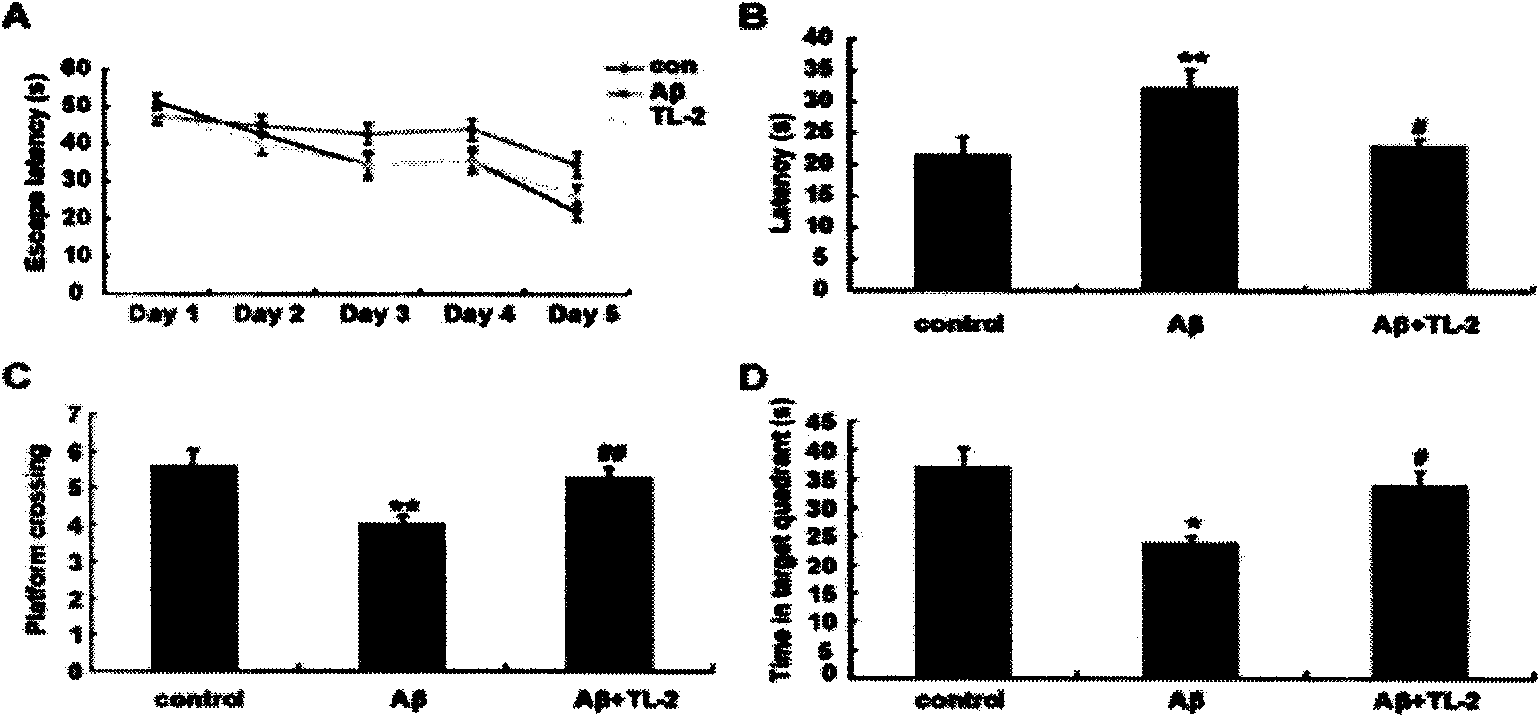Application of fungus polyketide in preparation of medicine used for treating alzheimer disease
A technology for Alzheimer's disease and fungal polyketides, applied in the field of application of fungal polyketides as drugs for the preparation of Alzheimer's disease
- Summary
- Abstract
- Description
- Claims
- Application Information
AI Technical Summary
Problems solved by technology
Method used
Image
Examples
Embodiment 1
[0071] In vivo studies have demonstrated that TL-2 has a therapeutic effect on AD mice induced by Aβ deposition:
[0072] Inject oligomeric Aβ into the bilateral hippocampus of male ICR mice to make AD mouse models, and treat them with intraperitoneal injection of TL-2. It has been proved by behavioral studies that TL-2 has a therapeutic effect on AD.
[0073] 1) Materials and methods
[0074] The oligomeric Aβ was injected into the bilateral hippocampus of male ICR mice to create an AD animal model. The experiment was randomly divided into 3 groups: normal ICR mice, Aβ-induced AD mice, Aβ-induced AD mice+TL-2 (Nanjing University, Nanjing, China) by intraperitoneal injection of 10 mg / kg, once a day, for 15 days, with 12 mice in each group.
[0075] Behavioral testing: the water maze test is a recognized method for testing the learning and memory abilities of animals. Morris water maze: the diameter of the circular pool is 122cm, the height is 75cm, the platform height is 50c...
Embodiment 2
[0079] In vitro studies have proved that TL-2 inhibits the neurotoxicity of Aβ and induces neuronal apoptosis to have a therapeutic effect on AD:
[0080] 1) Materials and methods
[0081] Culture of primary cortical neurons: Pregnant 15-17d wild-type Kunming mice were sacrificed by neck dislocation, and the embryos were collected and placed in a petri dish filled with cold PBS, and the cerebral cortex was separated, digested with 1X trypsin, and placed in a polymer Cultured in culture plate after lysine treatment, 4×10 5 Cells / ml, partly change the medium every 2-3d, and co-culture for 8-10d. The cells were cultured in a serum-free, phenol red-free and estrogen-free medium (Neurobasal plus Hepes, B27 and glutamine), in a 5% CO2 incubator at 37°C.
[0082] Human neuroblastoma cell culture: Human neuroblastoma cells, namely SH-SY5Y cells, were purchased from ATCC in the United States and grown in a medium containing 10% fetal bovine serum, 2mmol / L L-glutamine, penicillin (100...
Embodiment 3
[0092] In vitro studies have demonstrated that TL-2 activates the AKT / GSK3β signaling pathway to inhibit apoptosis:
[0093] In this part of the study, in order to further confirm that TL-2 inhibits apoptosis by regulating the AKT / GSK3β signaling pathway, the AKT inhibitor LY294002 and the GSK3β mutant plasmid GSK-3β-S9A will be used.
[0094] 1) Materials and methods
[0095] Quantitative determination of p-AKT, AKT, p-GSK3β, and GSK3β content in SH-SY5Y cells by Western blot: extract protein, then dissolve in 5Xloading Buffer, and boil for 5 minutes. Perform electrophoresis on a 4-20% polyacrylamide gel, and transfer the protein to a PVDF membrane. Block with 5% skimmed milk for 1 hour at room temperature. Add primary antibody rabbit anti-p-AKT (1:1000, Cell signaling), rabbit anti-AKT (1:1000, Cell signaling), rabbit anti-p-GSK3β (1:1000, Cell signaling), rabbit anti - GSK3β (1:1000, Cell signaling), overnight at 4°C, horseradish peroxidase-labeled secondary antibody (1:...
PUM
| Property | Measurement | Unit |
|---|---|---|
| Molecular weight | aaaaa | aaaaa |
Abstract
Description
Claims
Application Information
 Login to View More
Login to View More - R&D
- Intellectual Property
- Life Sciences
- Materials
- Tech Scout
- Unparalleled Data Quality
- Higher Quality Content
- 60% Fewer Hallucinations
Browse by: Latest US Patents, China's latest patents, Technical Efficacy Thesaurus, Application Domain, Technology Topic, Popular Technical Reports.
© 2025 PatSnap. All rights reserved.Legal|Privacy policy|Modern Slavery Act Transparency Statement|Sitemap|About US| Contact US: help@patsnap.com



